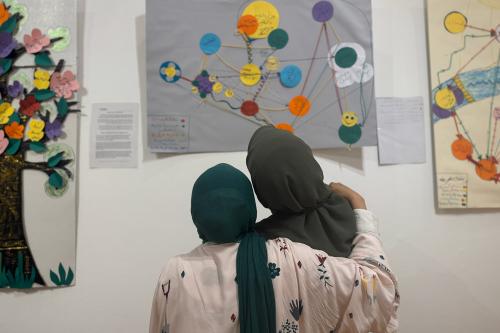I received my Ph.D. in child psychology and spent the next three decades of my life developing programs and conducting research to improve learning outcomes for young children. I wanted to make life better for children raised in difficult circumstances and I believed it was easier to bend a twig than a tree. I still want to make things better and I still think that early childhood is the place to start. But the other part of my professional life has been to listen to and promote high quality evidence in deciding what works to improve human welfare.
In that context I am concerned that preschool education has become like organic food — a creed in which adherents place faith based on selective consideration of evidence and without weighing costs against benefits. The result may be the overselling of generic preschool education as a societal good and a concomitant lack of attention to the differential impact of different types of preschool experience on different categories of children. So just as some but not all foods grown under some but not all organic conditions may be worth their price because of their extra nutritional benefits and lower environmental impacts, some but not all children exposed to some but not all preschool programs may experience lasting benefits. And because preschool education like organic food is expensive, it pays to know what works best, for whom, under what circumstances.
There is no better example of our need to think critically and consider the evidence about preschool education than Head Start, the federal program for children from low-income families that is administered through the U.S. Department of Health and Human Services. Head Start was begun in 1965 as part of the Lyndon Johnson administration’s war on poverty. Presently it serves about 1 million children annually (roughly 10% of the nation’s population of 3- and 4-year-olds[1]) at a yearly cost to the federal budget of approximately $8 billion. By way of comparison, the federal government appropriated $14.5 billion in FY 2012 to support the education of roughly 21 million children from disadvantaged families through Title I, Part A of the Elementary and Secondary Education Act – thus about $8,000 per child per year in Head Start vs. about $700 per child per year in all of the rest of primary and secondary education.
According to the U.S. Department of Health and Human Services, Head Start “promotes the school readiness of children ages birth to five from low-income families by enhancing their cognitive, social, and emotional development.”[2]
I don’t know about you but I have a certain amount of shall we say ambivalence about paying my federal taxes, what with all those debt payments, tax loopholes, and megabucks to the military for technology that never seems to work when we need it.[3] But I will gladly contribute my fair share to federal spending that meaningfully increases the school readiness of children from poor families. Their lives and the nation’s future depend on how well they will do in school. The odds are stacked against them. They start school behind and never catch up. We need to even those odds or at least narrow them a lot. The question is simple: Does Head Start do so?
One of the long-standing rules of thumb of communications is that Friday is the best day to release bad news – reporters have often taken off for the weekend, and so have readers. How about the Friday before Christmas if you really want to kill a story? So it was that on Friday, December 18, 2012 the U.S. Department of Health and Human Services released the Third Grade Follow-up to the Head Start Impact Study Final Report.[4] The Head Start Impact Study is one of the most ambitious, methodologically rigorous, and expensive federal program evaluations carried out in the last quarter century. It was planned during the Clinton administration,[5] implemented during the Bush administration, and reported during the Obama administration.
The study involved a lottery for children whose parents had applied for enrollment in oversubscribed Head Start centers. Children who won the lottery were eligible for enrollment in the Head Start program to which they were applicants and constituted the treatment group, whereas those who lost the lottery were denied enrollment in that Head Start program for that year and constituted the control group. During the school year in which the treatment group was in Head Start children in both groups were assessed on a variety of cognitive, social/emotional, and health outcomes and their parents were surveyed on their parenting practices. Both groups were followed up with similar measures in kindergarten, first grade, and again in third grade. The Head Start Impact Study is a randomized controlled trial, the gold-standard for evaluating the effectiveness of social and health programs. And it involves long-term follow-up of participants, which is both highly desirable and very unusual in evaluations of social and education programs.
The findings, in brief, are that there were effects favoring Head Start children on some outcome variables at the end of the Head Start year. However, these impacts did not persist. Both in the kindergarten and first grade follow-up data, released just short of three years ago[6], and the third grade follow-up data, released in December of 2012, there were no reliable differences in outcomes for children who won the lottery to attend Head Start vs. those who lost that lottery and served as the control group. In the words of the authors of the report, “by the end of 3rd grade there were very few impacts … in any of the four domains of cognitive, social-emotional, health and parenting practices. The few impacts that were found did not show a clear pattern of favorable or unfavorable impacts for children.”[7]
If this conclusion by the authors isn’t clear enough, I’ll put it in less academic language:
There is no measurable advantage to children in elementary school of having participated in Head Start. Further, children attending Head Start remain far behind academically once they are in elementary school. Head Start does not improve the school readiness of children from low-income families.
Whereas the authors of the Head Start Impact Study appropriately conclude that there were no favorable impacts of Head Start on children’s outcomes in middle childhood, they try to explain away the findings by appealing to the possibility of “sleeper effects”, i.e., long term effects of early intervention that appear after initial measureable effects have dissipated, perhaps mediated by improved socialization and emotional strength that do not show up in formal assessments of preschool children.
It is impossible to reject out-of-hand the hypothesis that children in the Head Start condition will be doing better 20 years from now than children in the control group. But research on the impacts of early intervention consistently shows that programs with longer-term impacts also evidence shorter-term impacts in elementary school. The two iconic preschool interventions that have been the subject of the longest term follow-ups (the Perry Preschool Study, and the Abecedarian Study) both generated impacts in elementary school of preschool program participation. In particular, the Perry Preschool participants were found to have significantly higher scores compared to their control group counterparts on intellectual and language tests at age 7 and on academic tests at age 9.[8] Similarly, the researchers responsible for the Abecedarian Study found significant differences between the preschool intervention and control groups on both reading and math performance at grade 8, and no differential fade-out of the size of the group differences that had been present during the preschool years.[9]
Likewise the 11 early intervention programs from the 1970s whose effects were summarized by the Consortium for Longitudinal Studies generated statistically significant effects on academic tasks during the initial elementary school grades.[10] The Tennessee Class Size intervention, cited by the authors of the present Head Start Impact Study as showing long term impacts, also showed significant impacts of kindergarten class size reduction through later grades: “A 5 percentile point gap opened up between students in small and regular-size classes by the end of kindergarten, and the gap stayed roughly constant in subsequent grades during the course of the experiment.”[11] Finally, the federal study of 12 preschool programs begun in 2002 utilized random assignment and followed up participants through the end of kindergarten, at which point the most effective programs at the end of the pre-K year continued to show effects on cognitive outcomes.[12]
In sum, methodologically rigorous longitudinal studies of the impact of early intervention programs have consistently found effects that persist into the elementary school years, whereas Head Start does not show these persisting effects. The U.S. Department of Health and Human Services is grasping at straws when it tries to explain away the disappointing findings of its own study of Head Start by appealing to sleeper effects. Why not follow Occam’s Razor: Among competing hypotheses, the one that makes the fewest assumptions should be selected. The most parsimonious explanation of the findings from the follow-up of the Head Start Impact Study participants is that Head Start has no long term impact.
If we want to do good we need to be hard-headed, not just do-gooders. It is time to be hard-headed about Head Start. The Obama administration deserves credit for understanding it has a problem. But the administration’s attempt to address the problem by putting more of its contracts with local Head Start agencies up for competition is a half-measure, at best.
There are several alternative models of service delivery. The one I favor has two parts. The first is granting a waiver to the Head Start Act to states that put forward an acceptable plan to the federal government for providing a coordinated system of early childhood education that has the goal of assuring school readiness for children for low-income backgrounds. Such a plan would need to include provisions for evaluating the quality and effectiveness of early childhood education centers and making that information available to the general public and to the parents of prospective enrollees. The second part of the plan, for states that receive the waiver, would be to let the federal dollars that currently go to local Head Start agencies follow the children of low-income families to the state-licensed early childhood education center that the parents choose for their child. Let low-income parents shop. Have the state provide good information to support parents in making choices and assure that all providers meet minimal quality standards.
Whether you like my plan or prefer some other approach, I hope you will agree that we must do something. A program that is supposed to prepare the neediest children in the nation for school and fails to do so is a program that needs fixing. The evidence tells us it is time to act.
Editor’s Note: The above is the first of two posts by Russ Whitehurst on early childhood education.
Read the second post, on universal and targeted pre-K »
[1] Head Start serves children from birth to five, but its predominant investment is in center-based care for 3- and 4-year olds. The nation’s census of 3- and 4-year-olds is available at http://www.census.gov/hhes/school/data/cps/2011/tab02-01.xls
[2] http://eclkc.ohs.acf.hhs.gov/hslc/hs/about
[3] See The Delta Force, Blackhawk Down, Zero Dark 30, or almost any other historically-grounded film that’s been released in the last 30 years that involves a U.S. military action that depends on helicopters.
[4] http://www.acf.hhs.gov/sites/default/files/opre/head_start_report.pdf
[5] Full disclosure: I served on the Clinton administration’s Advisory Committee on Head Start Research, which was responsible for planning the study.
[6] U.S. Department of Health and Human Services, Administration for Children and Families (January, 2010). Head Start Impact Study: Final Report. Washington, DC. http://www.acf.hhs.gov/programs/opre/hs/impact_study/reports/impact_study/hs_impact_study_final.pdf
[7] Page xvii, http://www.acf.hhs.gov/sites/default/files/opre/head_start_report.pdf
[8] http://www.highscope.org/file/Research/PerryProject/specialsummary_rev2011_02_2.pdf
[9] http://earlychildhoodrc.org/events/presentations/campbell-ramey.pdf
[10] Lazar, I., Darlington, R., Murray, H., Royce, J., & Snipper, A. (1982). Lasting effects of early education: A report from the Consortium for Longitudinal Studies. Monographs of the Society for Research in Child Development, 47(2-3, Serial No. 195).
[11] http://www.nber.org/papers/w7656.pdf
[12] http://ies.ed.gov/pubsearch/pubsinfo.asp?pubid=NCER20082009
The Brookings Institution is committed to quality, independence, and impact.
We are supported by a diverse array of funders. In line with our values and policies, each Brookings publication represents the sole views of its author(s).





